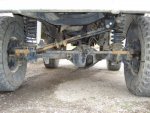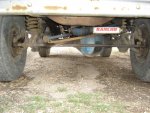No problem, but since you mentioned that you had poor handling before the lift went in, here is a check list for you to go through on your truck...
" sloppy " steering can be caused by a multitude of problems...
some are cheap fixes, some can become costly...
This is a list of things to check BEFORE attempting to adjust your steering box.
what condition are the radius arm bushings in
are all four "c" bushings in place (79 and prior)
if you have a two or three piece steering shaft, what condition are the joints in
drag link end and tie rod end play
ball joint condition
wheel bearing adjustment
track bar bushing condition (solid axle only)
toe in adjustment
tire pressures
tire condition
steering stabilizer condition
loose steering box to frame bolts ( quite common on EB's with larger tires)
is the sector shaft in the steering box "jumping" up and down...
(this would require the previously mentioned adjustment, NOT recommended for the novice wrench turner)
Twin Traction Beam bushings
It is fairly common for 80 and newer Fords to have cracks/ break in or at the engine crossmember or the frame
where the crossmember mounts, a tire on the ground "wiggle" can be used to check these areas.
These items will require two people to check,
the tie rod ,drag link,sector shaft,and all bushings can be checked by having a friend sit in the truck and "wiggle" the steering wheel back and forth about 1/2" each direction, carefully watch each joint or bushing and look for play at each piece, for the steering box to move on the frame, or for the sector shaft to "jump" up and down ( the sector is the piece of the steering box that the pitman arm bolts onto.)
The ball joints and wheel bearings can be checked by jacking under the diff until there is a couple of inches under the tire,( use a jack stand to support the truck) grab the tire at 12 and 6, feel for top to bottom movement ( in and out) at the places you've grabbed. If you can't feel movement, the wheel bearings are ok.
Have a friend do this so you can watch the ball joints... do the same top/bottom "wiggle":
movement in the ball joints indicates wear.
Get a two or three foot lever ( steel bar works well) put it under the tire ( make sure the truck is still secure on the jack stand) gently lift the bar while watching the ball joints for movement, allow the tire to drop all the way between lifts,
up/ down movement in the ball joints indicates wear.
Toe in can be checked by measuring the difference between the centre of the tread on the front and back of the tires across the truck. Measure the tires at the same level to get an accurate measurement. The difference is your "toe-in".
Depending on your tire size, this should be anywhere from 1/8 inch to 1/4 inch.
To check your steering stabilizer, simply unbolt one end of it, see if it extends and collapses using the same amount of force each way. It should have a steady resistance all the way through its travel in either direction, without being harder one way or the other.
One other item to check while your truck is in the air is the axle u-joint, lock the hub, turn the steering to full lock ( either direction) and turn the tire. If you feel a tight spot as the wheel turns, make note of where the grease zerk is, if during the next rotation, the same resistance is felt at the same point in rotation, you have a bad axle u-joint. If you change an axle u-joint DON'T forget to grease the spindle bearings!!!
Good luck in doing your inspection... if you find any thing that you feel is worn, make a note of it and take it to your local shop, most places around here will do a
steering inspection like this for about 1/2 hours labor.


